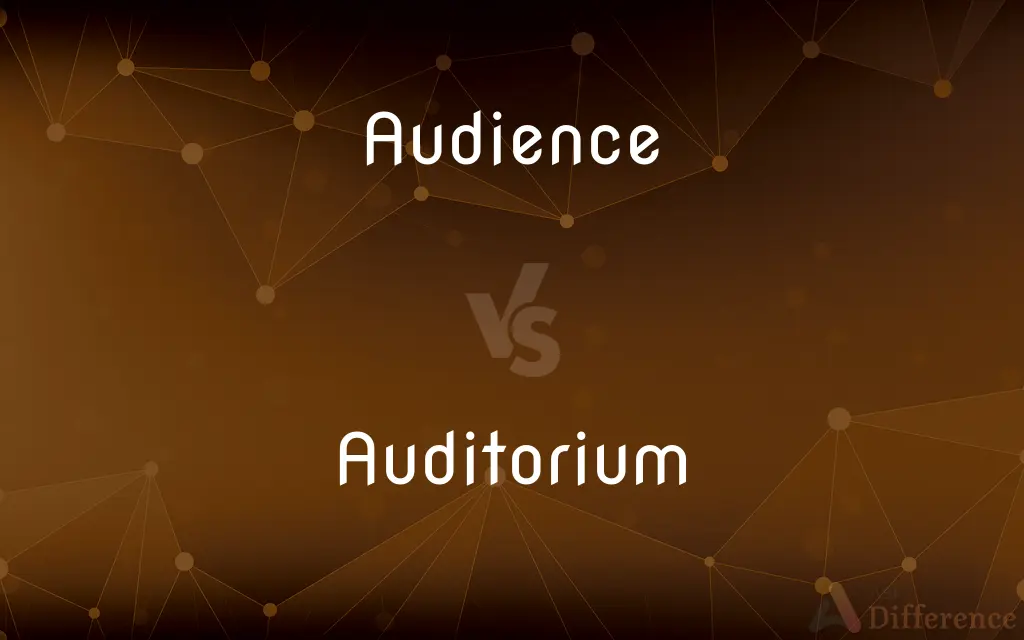Audience vs. Auditorium — What's the Difference?
By Tayyaba Rehman & Urooj Arif — Updated on March 22, 2024
An audience is a group of people gathered to watch or listen to a performance, while an auditorium is a venue designed for such events.

Difference Between Audience and Auditorium
Table of Contents
ADVERTISEMENT
Key Differences
An audience consists of individuals who come together to experience a live performance, lecture, movie, or another event, engaging with the content and often providing feedback through applause, laughter, or other reactions. In contrast, an auditorium is a physical space or building equipped with seating and acoustical engineering to accommodate and enhance the experience of both the audience and performers. While the audience plays an active role in the experience of a live event, contributing to the atmosphere and sometimes influencing the performance itself, the auditorium serves as the static environment in which these interactions take place.
The size and composition of an audience can vary greatly, from a few individuals in a small room to thousands in a large venue, reflecting the scale and appeal of the event. Auditoriums, on the other hand, are designed with specific capacities and features to suit different types of performances, such as concerts, theater productions, and lectures, with their design and layout influencing the quality of sound and visibility for the audience. This highlights the relationship between the two, where the auditorium must meet the needs of the expected audience to provide a satisfying experience.
Audience engagement is crucial for the success of an event, with performers or speakers often tailoring their delivery to the audience's reactions. The auditorium's design, including aspects like acoustics, seating arrangement, and sight lines, plays a significant role in facilitating this engagement, ensuring that the audience can comfortably interact with the performance. The dynamic between the audience and the performers is thus significantly influenced by the auditorium's environment.
The term "audience" can also imply a broader group not physically present, such as viewers of a television show or users engaging with content online. Meanwhile, the concept of an auditorium is specifically tied to a physical venue designed for live gatherings. This distinction underscores the versatility of the audience as a concept, extending beyond the confines of physical spaces like auditoriums.
Despite their differences, the audience and the auditorium are intrinsically linked, with the design and function of the auditorium being essential to accommodate the audience's needs and enhance their collective experience. The success of an event relies on the synergy between the audience's engagement and the auditorium's ability to provide a conducive environment for this interaction.
ADVERTISEMENT
Comparison Chart
Definition
Group of people gathered to experience a performance.
Venue designed for performances and events.
Role
Active participants, providing feedback and engagement.
Physical space that hosts the audience and event.
Variability
Size and composition can vary widely.
Fixed capacity and design, tailored to specific event types.
Engagement
Crucial for the event’s success, influenced by reactions.
Facilitates audience engagement through design and acoustics.
Context
Can extend beyond physical presence to online or broadcast.
Specifically a physical space for live gatherings.
Compare with Definitions
Audience
Interaction with performers is a key element.
The speaker engaged the audience with questions.
Auditorium
Design impacts the viewing and listening experience.
The auditorium’s seating arrangement offered unobstructed views for all.
Audience
Can be physically present or part of a virtual event.
The online audience participated through live comments.
Auditorium
Can vary in size from small lecture halls to large theaters.
The small auditorium was perfect for the intimate jazz performance.
Audience
Size and composition influence the event's atmosphere.
A diverse audience brought a range of responses to the performance.
Auditorium
A venue designed for public performances or meetings.
The auditorium was filled to capacity for the concert.
Audience
Individuals watching a play, concert, or lecture.
The audience gave a standing ovation.
Auditorium
Serves as a meeting point for community and cultural events.
The local auditorium hosts a variety of community events.
Audience
Engages with the performance through reactions.
The comedian tailored his jokes to the audience’s mood.
Auditorium
Equipped with seating, acoustics, and stage facilities.
The auditorium’s acoustics enhanced the music’s clarity.
Audience
An audience is a group of people who participate in a show or encounter a work of art, literature (in which they are called "readers"), theatre, music (in which they are called "listeners"), video games (in which they are called "players"), or academics in any medium. Audience members participate in different ways in different kinds of art; some events invite overt audience participation and others allowing only modest clapping and criticism and reception.
Auditorium
An auditorium is a room built to enable an audience to hear and watch performances. For movie theatres, the number of auditoria (or auditoriums) is expressed as the number of screens.
Audience
The assembled spectators or listeners at a public event such as a play, film, concert, or meeting
He asked for questions from members of the audience
Auditorium
A large room to accommodate an audience in a building such as a school or theater.
Audience
A formal interview with a person in authority
He demanded an audience with the Pope
Auditorium
A large building for public meetings or performances.
Audience
Formal hearing.
Auditorium
A large room for public meetings or performances
Audience
A group of viewers or listeners, especially those present at a performance (as a play, concert, or lecture) or a public event (as a rally).
Auditorium
(in a theater, etc.) the space where the audience is located
Audience
The readership for printed matter, as for a book.
Auditorium
The part of a church, theater, or other public building, assigned to the audience.
Audience
A group of people who follow or admire an artist or performer
The tenor expanded his audience by recording popular songs as well as opera.
Auditorium
A building, or a room within a building, containing a large open space for public gatherings, and often having a raised stage where speakers or presentations may be easily viewed by the audience.
Audience
A formal hearing, as with a religious or state dignitary.
Auditorium
The area of a theater or concert hall where the audience sits
Audience
An opportunity to be heard or to express one's views.
Audience
A group of people within hearing; specifically, a large gathering of people listening to or watching a performance, speech, etc.
We joined the audience just as the lights went down.
Audience
Hearing; the condition or state of hearing or listening.
Audience
A widespread or nationwide viewing or listening public, as of a TV or radio network or program.
Audience
A formal meeting with a state or religious dignitary.
She managed to get an audience with the Pope.
Audience
The readership of a book or other written publication.
"Private Eye" has a small but faithful audience.
Audience
A following.
The opera singer expanded his audience by singing songs from the shows.
Audience
(historical) An audiencia (judicial court of the Spanish empire), or the territory administered by it.
Audience
The act of hearing; attention to sounds.
Thou, therefore, give due audience, and attend.
Audience
Admittance to a hearing; a formal interview, esp. with a sovereign or the head of a government, for conference or the transaction of business.
According to the fair play of the world,Let me have audience: I am sent to speak.
Audience
An auditory; an assembly of hearers. Also applied by authors to their readers.
Fit audience find, though few.
He drew his audience upward to the sky.
Audience
A gathering of spectators or listeners at a (usually public) performance;
The audience applauded
Someone in the audience began to cough
Audience
The part of the general public interested in a source of information or entertainment;
Every artist needs an audience
The broadcast reached an audience of millions
Audience
An opportunity to state your case and be heard;
They condemned him without a hearing
He saw that he had lost his audience
Audience
A conference (usually with someone important);
He had a consultation with the judge
He requested an audience with the king
Common Curiosities
Can an audience participate in an event without being in an auditorium?
Yes, an audience can participate in events virtually through online platforms or by watching broadcasts, extending beyond the physical auditorium.
What defines an audience?
An audience is defined by individuals gathered to watch, listen to, or interact with a performance or event, whether in person or virtually.
How does audience engagement affect a performance?
Audience engagement can significantly impact a performance, with performers often adapting to audience feedback to enhance the experience.
How does an auditorium enhance an event?
An auditorium enhances an event through its design, acoustics, and facilities, ensuring a high-quality experience for both the audience and performers.
What are the key features of an auditorium?
Key features include seating arrangements, acoustic design, stage visibility, lighting, and sometimes technical equipment for performances.
How do performers interact with an audience in a large auditorium?
Performers use amplification, engaging content, and sometimes interactive technology to connect with the audience, despite the large venue size.
How is the size of an audience determined for an event?
The size of an audience is often determined by the event’s appeal, marketing efforts, and the capacity of the venue, including auditoriums.
What role does technology play in connecting audiences with performances?
Technology enhances the connection through improved sound and lighting in auditoriums and enables virtual participation for remote audiences.
Are auditoriums used only for entertainment events?
No, auditoriums can host a wide range of events, including educational lectures, community meetings, and corporate presentations.
Can the design of an auditorium affect an event’s success?
Yes, the auditorium’s design, especially its acoustics and seating, can greatly affect the event’s success by influencing audience satisfaction.
Share Your Discovery

Previous Comparison
Trade vs. Enterprise
Next Comparison
Porifera vs. CoelenterataAuthor Spotlight
Written by
Tayyaba RehmanTayyaba Rehman is a distinguished writer, currently serving as a primary contributor to askdifference.com. As a researcher in semantics and etymology, Tayyaba's passion for the complexity of languages and their distinctions has found a perfect home on the platform. Tayyaba delves into the intricacies of language, distinguishing between commonly confused words and phrases, thereby providing clarity for readers worldwide.
Co-written by
Urooj ArifUrooj is a skilled content writer at Ask Difference, known for her exceptional ability to simplify complex topics into engaging and informative content. With a passion for research and a flair for clear, concise writing, she consistently delivers articles that resonate with our diverse audience.














































